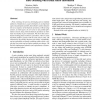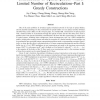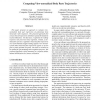2711 search results - page 12 / 543 » Mapping sequences by parts |
ICRA
2002
IEEE
14 years 13 days ago
2002
IEEE
Orienting parts that measure only a few micrometers in diameter introduces several challenges that need not be considered at the macro-scale. First, there are several kinds of sti...
ICRA
1998
IEEE
13 years 11 months ago
1998
IEEE
Parts orienting, the process of bringing parts in initially unknown orientations to a goal orientation, is an important aspect of automated assembly. Bowl feeders used in industry...
CORR
2010
Springer
13 years 4 months ago
2010
Springer
One of the main problems in all-optical packet-switched networks is the lack of optical buffers, and one feasible technology for the constructions of optical buffers is to use opt...
CRV
2007
IEEE
14 years 1 months ago
2007
IEEE
This paper proposes an approach to compute viewnormalized body part trajectories of pedestrians from monocular video sequences. The proposed approach first extracts the 2D trajec...
CAPTECH
1998
Springer
13 years 11 months ago
1998
Springer
A method for matching sequences from two perspective views of a moving person silhouette is presented. Regular (approximate uniform thickness) parts are detected on an image and a ...



